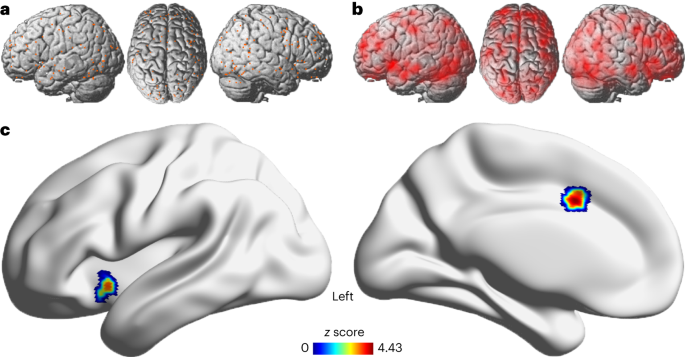
Aberrant brain activity in pedophilia links to receptor distribution, gene expression, and behavior
- Select a language for the TTS:
- UK English Female
- UK English Male
- US English Female
- US English Male
- Australian Female
- Australian Male
- Language selected: (auto detect) - EN
Play all audios:

Despite an estimated lifetime prevalence of 0.5–1.0% in men and high public concern, no effective treatment is known for pedophilic disorder. Here, we provide robust meta-analytic evidence
that brain activity is not generally altered in pedophilia but deviates specifically in response to sexual stimuli. We show how this meta-analysis-derived functional brain alteration pattern
in pedophiles maps onto underlying neurophysiology in terms of specific neurotransmitter systems and their corresponding gene expression as well as to behavioral aspects. We report robust
and specific associations between functional brain alterations in pedophiles and the distribution of the serotonergic 5-HT1B receptor as derived from in vivo positron emission tomography
data as well as gene expression analyses. At the functional level, the alterations related to cognitive processes including self-regulation and goal-directed behavior. These findings warrant
further investigation into the molecular mechanisms underlying pedophilia and point toward the development of specific pharmacological interventions.
Coordinates used in the meta-analyses are available from the included studies that are referenced in the Supplementary Information. Transmitter and receptor atlases are shipped with the
JuSpace Toolbox (https://github.com/juryxy/JuSpace/). Neurosynth data are available at https://neurosynth.org/. Allen Human Brain Atlas data are available from https://human.brain-map.org/.
ALE software is available at https://www.brainmap.org/ale/, the JuBrain Anatomy Toolbox 3.0 at https://github.com/inm7/jubrain-anatomy-toolbox, the JuSpace Toolbox 1.4 at
https://github.com/juryxy/JuSpace, Neurosynth 0.3.8 at https://github.com/neurosynth/neurosynth, neuromaps 0.0.3 at https://github.com/netneurolab/neuromaps, and the Talairach Client 2.4.3
at http://www.talairach.org/client.html.
Department of Psychiatry, Psychotherapy and Psychosomatics, Faculty of Medicine, RWTH Aachen University, Aachen, Germany
Gereon J. Schnellbächer, Viktoria Pietsch, Katrin Sakreida & Timm B. Poeppl
Institute of Neuroscience and Medicine, Brain & Behaviour (INM-7), Research Centre Jülich, Jülich, Germany
Institute of Systems Neuroscience, Medical Faculty, Heinrich Heine University Düsseldorf, Düsseldorf, Germany
McConnell Brain Imaging Centre, Montréal Neurological Institute, McGill University, Montréal, Quebec, Canada
Faculty of Psychology, FernUniversität in Hagen (University of Hagen), Hagen, Germany
Department of Diagnostic and Interventional Radiology and Nuclear Medicine, University Medical Center Hamburg–Eppendorf, Hamburg, Germany
Department of Psychiatry and Psychotherapy, University Hospital Jena, Jena, Germany
Department of Psychiatry and Psychotherapy, Faculty of Medicine, University of Regensburg, Regensburg, Germany
T.B.P. designed the study; S.B.E. gave conceptual advice. V.P., K.S. and T.B.P. gathered data for the meta-analyses. T.B.P. conducted the meta-analyses with advice of S.B.E. J.D. and T.B.P.
conducted the neurotransmitter analyses. J.D. performed the gene expression analyses. J.Y.H. and R.D.M. provided the behavioral profiling. G.S. and T.B.P. wrote the manuscript. A.M., I.R.
and M.W. discussed the results and implications. All authors commented on the manuscript at all stages.
Nature Mental Health thanks Kirsten Jordan, Cristina Scarpazza and the other, anonymous, reviewer(s) for their contribution to the peer review of this work.
Publisher’s note Springer Nature remains neutral with regard to jurisdictional claims in published maps and institutional affiliations.
Springer Nature or its licensor (e.g. a society or other partner) holds exclusive rights to this article under a publishing agreement with the author(s) or other rightsholder(s); author
self-archiving of the accepted manuscript version of this article is solely governed by the terms of such publishing agreement and applicable law.
Anyone you share the following link with will be able to read this content:
